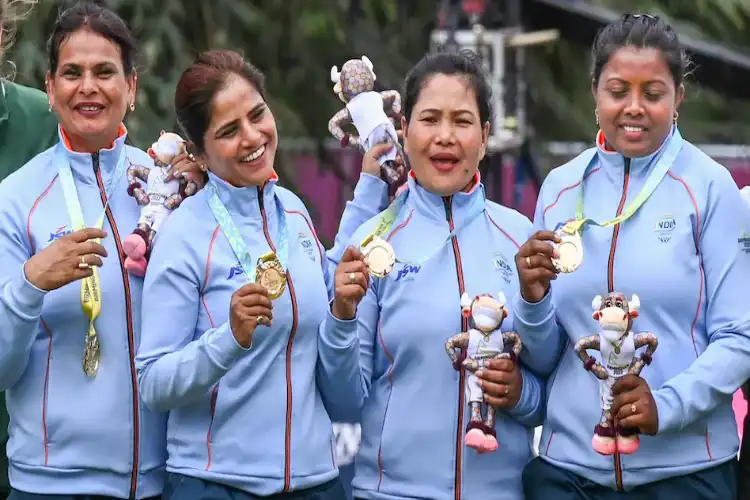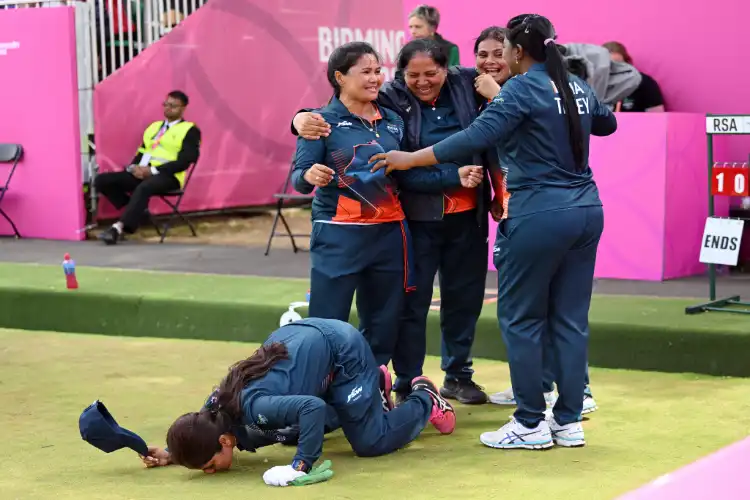
Nakul Shivani/New Delhi
Four hitherto unknown women have suddenly caught the imagination of the entire country.
Lovely Choubey, Pinki, Nayan Moni Saikia, and Rupa Rani Tirkey had the nation in awe as they catapulted to glory on a sunny Birmingham afternoon at Victoria Park on Tuesday.
Gold Medal – India!
As these words reverberated the Lemington Spa arena, with the tricolor atop the rest and a handful of Indian supporters in the stands, the Indian Lawn Bowls team had done the unimaginable – beaten superpowers in the sport like New Zealand and South Africa on their way to etch their names in history books.
Most importantly, they made India fall in love with a new sport. “All those who did not know about Lawn Bowls and thought we are just making up the numbers, this is a response to them,” said Anju Luthra, the team manager after the match.
The sport was introduced by the British in India. It was originally meant for recreation. Rolling balls on a lush green lawn with coffee breaks in between – the game was a good leisurely activity.
Most importantly, it could be played by all age groups – from a ten-year-old to octogenarians. Anyone can play this sport. This sport does not require either the muscles of a weightlifter or the stamina of a runner. It needs concentration and patience which has no age barrier.

The Indian team after their victory over South Africa in the final
From being played by a handful of expatriates, the sport gradually moved to clubs, jute mills, and tea-estates in the British empire. But once the British moved out of the country, the onus of keeping the sport alive in India fell on amateur enthusiasts.
In the 1980s a handful of active bowlers took it upon themselves to resurrect this dying sport in the country. The Bowling Federation of India was formed in 1985 and got affiliated with the Indian Olympic Association and the world body in 1990. As amateurs got together, national teams were formed and sent on small budgets to international tournaments.
While at the Asian level India has recorded creditable performances, at the Commonwealth Games, where competition is tough, with countries like England, Scotland, South Africa, Australia, and New Zealand taking part, India has generally only added to the numbers – till Birmingham happened.
The four pathbreakers for India – Lovely Choubey is a constable in the Jharkhand Police, Rupa Rani Tirkey is a Sports District Officer in Ramgarh, Nayamoni Saikia is a constable with the Assam Police and Pinki is a sports teacher in a Delhi school.
While they will all be back doing their day jobs unlike their more illustrious compatriots who play more commercially viable sports, here’s hoping the historic gold at the CWG 2022 games will open the doors for a better and brighter future not just for the players, but the sport as well.
ALSO READ: CWG 2022: Indian women clinch historic gold in lawn bowls
How is Lawn Bowls played?
Each match is played over separate rounds known as ‘Ends’.
Competitors take turns to roll spherical-shaped balls with flattened sides with a weight bias across a green towards the target called ‘Jack’.
In singles, each player has to roll four balls per ‘End’, while in pairs, triples, and fours each competitor rolls two balls intending to get them as close to the ‘Jack’ as possible. Points are awarded for each ball closest to the target during each ‘End’.
In singles the winner who reaches 21 points first wins. In Team events, the winner is determined by the cumulative score at the end of 18 ‘Ends’.
